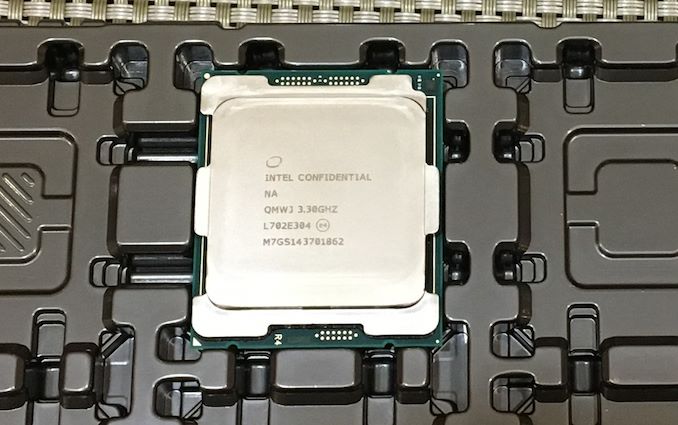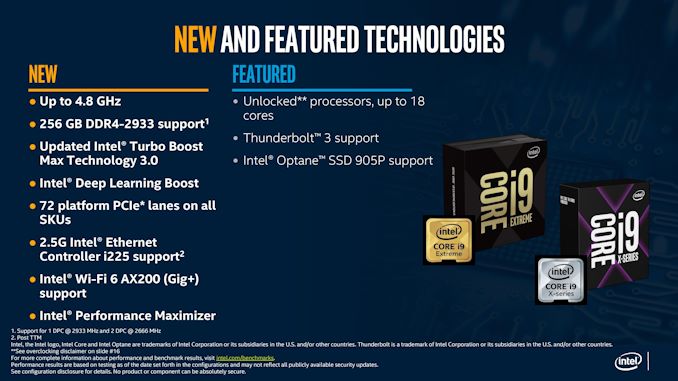Intel's Cascade Lake-X CPU for High-End Desktops: 18 cores for Under $1000
by Dr. Ian Cutress on October 1, 2019 6:35 PM EST- Posted in
- CPUs
- Intel
- HEDT
- LGA2066
- Cascade Lake

With someone in the press having broken their embargo earlier today, Intel is lifting the lid earlier than planned on their upcoming Cascade Lake-X family of processors for the high-end desktop (HEDT) market. Similar to the way Intel's Cascade Lake based Xeon Scalable processors are a further revision of their Skylake Xeons, offering clock speed increases and security fixes in hardware, the new HEDT processors will grant higher frequencies, more memory capacity, and better protection against side-channel attacks. The key numbers however are the big drop in Intel's pricing: Intel will be releasing its 18-core part, the Core i9-10980XE, for under $1000.
| Intel Cascade Lake-X | |||||||
| AnandTech | Cores Threads |
Base | All Core |
TB2 | TB3 | TDP | Price (1ku) |
| Core i9-10980XE | 18C / 36T | 3.0 | 3.8 | 4.6 | 4.8 | 165 W | $979 |
| Core i9-10940X | 14C / 28T | 3.3 | 4.1 | 4.6 | 4.8 | 165 W | $784 |
| Core i9-10920X | 12C / 24T | 3.5 | 4.3 | 4.6 | 4.8 | 165 W | $689 |
| Core i9-10900X | 10C / 20T | 3.7 | 4.3 | 4.5 | 4.7 | 165 W | $590 |
| Skylake-X (previous generation) | |||||||
| Core i9-9980XE | 18C / 36T | 3.0 | 4.5 | 4.7 | 165 W | $1979 | |
| Core i9-9940X | 14C / 28C | 3.3 | 4.5 | 165 W | $1387 | ||
| Core i9-9920X | 12C / 24T | 3.5 | 4.5 | 165 W | $1189 | ||
| Core i9-9900X | 10C / 20T | 3.5 | 4.5 | 165 W | $989 | ||
This pricing is a significant shift in Intel's strategy, and a number of fingers will be pointed at AMD as having made this happen. Next month AMD is set to launch its 16-core Ryzen 9 3950X at $749, which will offer 16 PCIe 4.0 lanes for slots (+4 for M.2, +4 for chipset) and support for 128 GB of DRAM. So Intel needed something similarly speedy, but with more PCIe lanes and more memory support that they could offer for just a bit more, leading to the 10980XE for $979. Ultimately, the on-shelf price is often just slightly higher than tray price, so don't be surprised if retail prices land at around $1000.
All the CPUs will support 256 GB of quad-channel memory (up from 128 GB), and have 48 PCIe 3.0 lanes (up from 44). Memory speed support is listed as DDR4-2933 for 1 DIMM per channel, and DDR4-2666 for 2 DIMMs per channel. All these CPUs have a TDP of 165 W, which Intel states will help the CPUs to turbo longer under Intel's recommended settings (as we know, consumer motherboard manufacturers like to ignore these anyway). All these CPUs are supported in X299 motherboards.
There is no 16-core in this stack, with Intel's official reasoning being that they assess the market with each generation and they don't believe there's a suitable price point for such a part when the 14C and 18C parts are so close. Most people will point the finger and say that no-16 core Intel part means no direct comparison with the Ryzen 9 3950X, which is something to think about.
Another point to note is that Intel has stopped this stack at the 10 core and no lower. This means that there will be no cross over between Intel's consumer processor stack and the HEDT stack, with users needing to spend just a little bit more from the Core i9-9900K/KF to reach up to the Core i9-10900X. It will be interesting to see where Intel's Core i9-9900KS fits in, although that still only has dual channel memory and 16 PCIe 3.0 lanes.
Intel lists Wi-Fi 6 and 2.5GbE support on these new processors - to clarify, Intel means external controllers here. For some odd reason when Intel says support, it could mean internal to the chipset or external via a controller; this is messaging I've railed against for a while, as it ends up confusing for enthusiasts, especially when this is an enthusiast platform. It does mean however that we get official information about Intel's 2.5GbE controllers, which we've been waiting on for a couple of years. Intel stated that these controllers will be ready at a later date, and more information to follow. (The controllers are currently listed on Intel's ARK database, but as 1 GbE controllers for some reason.)
These CPUs will have the same security mitigations as the Cascade Lake Xeon processors, with updated hardware mitigations for a number of side channel attacks. We are waiting to hear from Intel if the firmware that supports these processors will also have additional fixes in for Zombieload by default.
One question about this launch is surrounding Intel’s 14nm capacity. Within the last week, there have been reports that despite Intel’s best efforts and promises to match demand, and that Q3 and upcoming for Q4 is going to be busier than expected. We reached out to Intel last week for clarification, and the company said that the bulk of its capacity is focusing on the high-end processors in the market: the Xeon Scalable, the Core i9, Core i7, and Core i5. It will be interesting to see if launching another family of products is going to put additional strain on Intel’s capacity and demand.
With AMD's recent Zen 2 Ryzen 3000 series launch on 7nm earlier in the year, Threadripper 3 coming later this year, and Intel swinging another generation of 14++ into the high-end desktop market, Intel is going to have some tough times. Don't get me wrong, this pricing update from Intel is a good thing for users, especially those looking at implementing things like DL Boost to their workflow, but this market is suddenly turning very aggressive, and it will be interesting to see if Intel can be agile enough to keep pace.
Intel's Cascade Lake-X processors will be available in November. More details should be released nearer to launch.











162 Comments
View All Comments
nevcairiel - Thursday, October 3, 2019 - link
Only the core running AVX512 load will clock down, the others are unaffected - as long as the power budget is not affected.But even with one core slowing down, it takes a couple milliseconds to clock back up once its done with AVX512, and milliseconds are an eternity in CPU world.
Oliseo - Thursday, October 3, 2019 - link
"Only the core running AVX512 load will clock down, the others are unaffected - as long as the power budget is not affected."This simply isn't true at all. Take the i9 9900k, it has a turbo of 5ghz on two cores, but only if the other cores aren't used. As soon as the other cores are used, that turbo drops.
It's exactly the same for AVX as well.
porina - Wednesday, October 2, 2019 - link
On the AVX offset, Zen 2 isn't immune from the higher power usage with AVX code. In my testing of 3600 and 3700X at stock, both hit the PPT limit of 88W and power throttle so you get lower clocks than if running non-AVX code. Basically AMD have a better limiter than using offset, but it is still a limiter.eek2121 - Wednesday, October 2, 2019 - link
You can't compare Zen 2 to Intel chips in this regard. An Intel chip can easily run close to 200 watts on AVX. They have completely different implementations. Also, an AVX heavy workload on my 1950X throttles the 1950X below the 3400 MHz base clock (3349 MHz, and to think everyone is complaining about the Zen2 clocks being slightly off...lol).Bulat Ziganshin - Wednesday, October 2, 2019 - link
>Intel doesn't have 512 bit AVX registers so it has to do 2 passes for 512 just like AMD doesAVX-512 improves performance on Intel cpus up to 2x, and that's all you need to know
eek2121 - Wednesday, October 2, 2019 - link
Not really, no.Korguz - Wednesday, October 2, 2019 - link
Bulat Ziganshin " AVX-512 improves performance on Intel cpus up to 2x, and that's all you need to know " prove itKevin G - Thursday, October 3, 2019 - link
The performance increase can actually go beyond a 2x increase with AVX-512:https://www.anandtech.com/show/14664/testing-intel...
Not only is the register width doubled to 512 bit wide, there are more of them including new mask registers. Depending the algorithm and compiler, going beyond a 2x performance increase is indeed possible depending on where the previous bottleneck was in the code. However, such gains are certainly not common.
Oliseo - Thursday, October 3, 2019 - link
"AVX-512 improves performance on Intel cpus up to 2x, and that's all I know"nevcairiel - Wednesday, October 2, 2019 - link
In comparison to Ryzen 3000, there is of course also more memory channel and PCIe lanes, and in comparison to low-end Thread Rippers likely going to be a big ST advantage.Personally thats why I liked Intel HEDT CPUs in the past (ie. first SKL-X), they offered strong MT and strong ST in one package, while with most other choices you had to pick, either get MT (from TR or similar), or ST from Intel consumer CPUs.
On an actual workstation (where I favor the PCIe lanes and memory throughput), in contrast to servers etc, both ST and MT are still very important, as different applications require different things.
We'll have to see how the new TR is positioned in ST load as well.